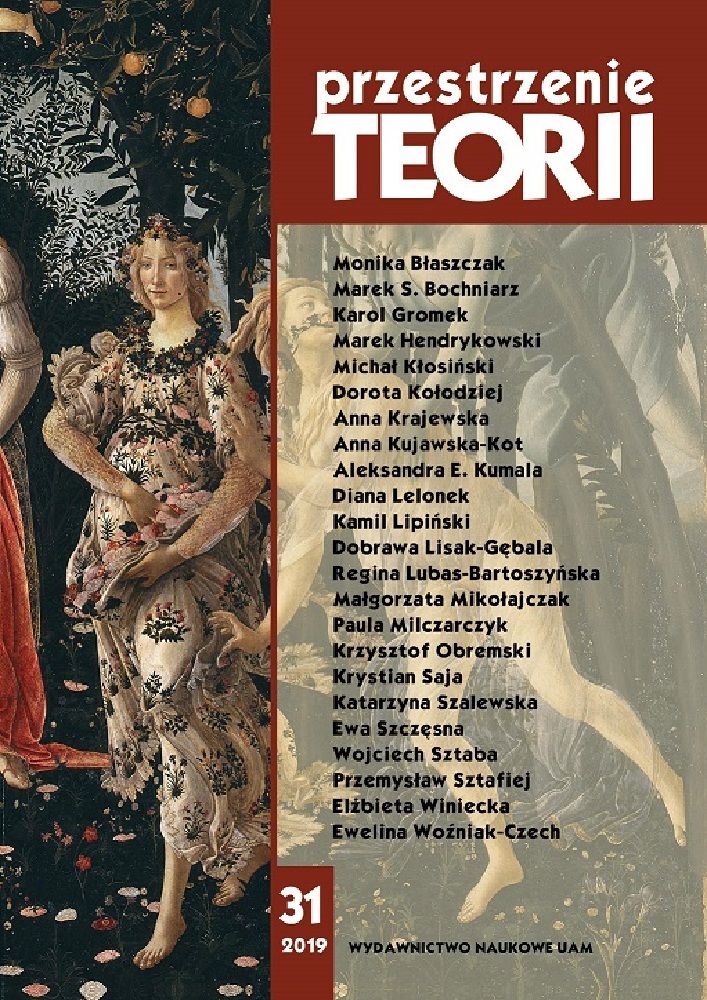Abstract
The aim of the article is to analyse the aesthetic aspects of the reception and creation of art by people with hearing impairments. For most people, hearing loss is unimaginable and is often understood only in the context of communication problems. Meanwhile, deaf people perceive their otherness completely differently. Deafness is a total experience, affecting not only the physical aspect, but also changing the perception of reality as a whole. Divergences in the way of perceiving the world, resulting from the exclusion of one of the basic senses, are particularly visible in the field of art, especially in those areas that use sound effects. The large variety of types of deafness does not allow for broad generalizations or building some kind of universal theory of reception. Therefore, from the perspective of deaf people, contact with art is very individual and intimate, which also affects the issue of their artistic creation. The author of the article touches upon the problem of the visuality of sign language and its artistic possibilities. She analyses the perception preferences of people with hearing impairments, exposing the issue of polysensory perception, and presents the most interesting artistic projects created both by the deaf and those that allow to build multidirectional relations between the parallel worlds of the deaf and hearing people.References
Bazak A., Poezja migana, 2014, <https://www.youtube.com/watch?v=XxxpXwwgHwU> [dostęp: 15.11.2018].
Bazak A., „Żegluga”. Warsztaty poezji miganej, 2018, <http://literatura.wroclaw.pl/wydarzenia/zegluga-warsztaty-poezji-miganej/> [dostęp: 18.11.2018].
Berleant A., Prze-myśleć estetykę. Niepokorne eseje o estetyce i sztuce, przeł. M. Korusiewicz, T. Markiewicz, red. K. Wilkoszewska, Kraków 2007.
Czym jest pętla indukcyjna?, <https://petlaindukcyjna.pl/czym-jest-petla-indukcyjna/> [dostęp: 26.11.2018].
Dobrze, że jesteś, 2014, <https://www.youtube.com/watch?v=XlLKOeHwK7s> [dostęp: 26.11.2018].
Dunaj M., GŁUCHY-ŚWIAT. Głuchota w perspektywie antropologii zaangażowanej, Łódź 2015, <http://dspace.uni.lodz.pl/xmlui/bitstream/handle/11089/8015/dunaj-swiatgluchy-gluchota-w-perspektywie-antropologii-zaangazowanej.pdf?sequence=1&isAllowed=y> [dostęp: 20.11.2018].
Godlewska-Byliniak E., Odzyskiwanie obecności. Niepełnosprawność w teatrze i performansie, Warszawa 2017.
Greniuk A., Cisza pełna dźwięków, 2015, <http://www.niepelnosprawni.pl/ledge/x/251046> [dostęp: 26.11.2018].
<http://jezykowaoaza.pl/2015/03/jezyki-niezwykle-polski-jezyk-migowy/> [dostęp: 28.11.2018].
Kijewska A., Jak narysować dźwięk?, <https://www.vice.com/pl/article/mvz8dy/jak-narysowac-dzwiek> [dostęp. 16.11.2018].
Koczorowski O., Po wernisażu wystawy GAG w Katowicach, 2018, <http://www.gag.art.pl/2018/02/wernisazu-wystawy-gag-katowicach/> [dostęp: 16.11.2018].
Kowalski K., Architektura i rozwiązania techniczne, [w:] ABC Gość niepełnosprawny w muzeum, „Szkolenia Narodowego Instytutu Muzealnictwa i Ochrony Zbiorów” 2013, 2, <https://www.nimoz.pl/files/publications/17/ABC_Gosc_niepelnosprawny_lekki.pdf> [dostęp: 26.11.2018].
Legierska A., „Jeden gest”, reż. Wojciech Ziemilski, <https://culture.pl/pl/dzielo/jedengest-rez-wojciech-ziemilski> [dostęp: 10.11.2018].
Legierska A., Ziemilski: Jak zobaczyć głos, 2016, <https://culture.pl/pl/artykul/ziemilskijak-zobaczyc-glos-wywiad> [dostęp: 10.11.2018].
„Miganie pantoMimiczne – magia języka migowego” (Visual Vernacular), <http://pzg.warszawa.pl/miganie-pantomimiczne/> [dostęp:18.11.2018].
Napisy dla osób niesłyszących i słabosłyszących – zasady tworzenia, 2012, <http://dzieciom.pl/wp-content/uploads/2012/09/Napisy-dla-nieslyszacych-zasady-tworzenia.pdf> [dostęp: 20.11.2018].
Odziomek M., Dźwięk zaklęty w obrazach, czyli malarstwo zdobywczyni „artNobla 2015”, 2016, <http://katowice.wyborcza.pl/katowice/1,35018,19604370,dzwiek-zaklety-w-obrazach-czyli-malarstwo-zdobywczyni-artnobla.html> [dostęp: 16.11.2018].
Pakalska E., Niedoskonały odbiornik < https://pakalska.blogspot.com/2015/03/niedoskonay-odbiornik.html > [dostęp: 27.06.2019].
Poezja migana, <http://pzg.warszawa.pl/poezja-migana/> [dostęp: 25.11.2018].
Sacks O., Zobaczyć głos. Podróż do świata ciszy, przeł. A. Małaczyński, Poznań 1998.
Stępniewicz J., Bez znieczulenia. Recenzja „Plemienia” Myrosława Słaboszpyckiego, 2015, <https://kulturaliberalna.pl/2015/06/16/bez-znieczulenia-recenzja-plemienia-myroslawa-slaboszpyckiego/> [dostęp: 29.10.2018].
Szwoch G., Analiza dźwięków muzycznych, 2018, <https://sound.eti.pg.gda.pl/student/akmuz/02-Analiza.pdf> [dostęp: 16.11.2018].
Żórawska A., Gość z niepełnosprawnością słuchu w muzeum, [w:] ABC Gość niepełnosprawny w muzeum. Szkolenia Narodowego Instytutu Muzealnictwa i Ochrony Zbiorów, 2013, nr 2, <https://www.nimoz.pl/files/publications/17/ABC_Gosc_niepelnosprawny_lekki.pdf> [dostęp: 10.11.2018].
License
Authors
Authors of texts accepted for publication in Przestrzenie Teorii are required to complete, sign and return to the editor's office the Agreement for granting a royalty-free license to works with a commitment to grant a CC sub-license.
Under the agreement, the authors of texts published in Przestrzenie Teorii grant the Adam Mickiewicz University in Poznań a non-exclusive, royalty-free license and authorize the use of Attribution-NonCommercial-NoDerivatives 4.0 International (CC BY-NC-ND 4.0) Creative Commons sub-license.
The authors retain the right to continue the free disposal of the work.
Users
Interested Internet users are entitled to use works published in Przestrzenie Teorii since 2015, for non-commercial purposes only, under the following conditions:
- attribution - obligation to provide, together with the distributed work, information about the authorship, title, source (link to the original work, DOI) and the license itself.
- no derivatives - the work must be preserved in its original form, without the author's consent it is not possible to distribute the modified work, such as translations, publications, etc.
Copyrights are reserved for all texts published before 2015.
Miscellaneous
Adam Mickiewicz University in Poznań retains the right to magazines as a whole (layout, graphic form, title, cover design, logo etc.).
